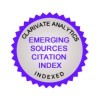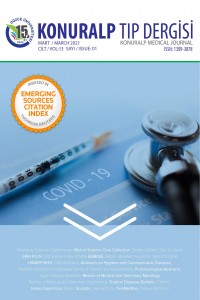Abstract
Amaç: Cep telefonu ile kalp arasındaki mesafe değişiminin kalp hızı değişkenleri üzerindeki etkisi incelenerek, CT kalbe olan uzaklığı ile dolaşım sisteminin etkilenimi incelendi.
Yöntem: Cep telefonu kullanan sağlıklı gönüllüler bu çalışmaya dâhil edildi. Sağ el kulak mesafesi ile sol el kulak mesafesi arasındaki yaklaşık 4 santimetrelik mesafe farkından faydalanarak gönüllüler, sağ el baskın ve sol el baskın bireyler olarak iki gruba ayrıldı. Toplam 31 sağ el dominant (Grup 1) ve 32 sol el dominant (Grup 2) gönüllü kaydedildi. HRV, ticari olarak temin edilebilen FDA onaylı üç kanallı Holter izleme cihazı (Holter ECG Kaydedici DMS300-4A) tarafından otomatik olarak hesaplandı.
Bulgular: Birinci grubun ortalama tragustan apekse mesafesi 37.5 cm ve ikinci grubun ortalaması 33.6 cm idi. N – N'lerin standart sapması (SDNN), N – N'lerin (SDANN) 5 dakikalık ortalama değerlerinin standart sapması, N – N'lerin (RMSSD) kök ortalama kare ardışık farkı, düşük- arasında istatistiksel olarak anlamlı bir fark yoktu. frekans (LF) ve yüksek frekans (HF) değerleri ve iki grup arasındaki LF / HF oranı. Her 5 dakikalık aralık için 50 ms'den büyük olan ardışık N-N farklarının yüzdesi (pNN% 50) Grup 2'de Grup 1'e göre anlamlı olarak daha düşüktü (p = 0,014).
Sonuçlar: Bulgularımız, CT'lerde kalp mesafesindeki küçük bir artışın bile kardiyovasküler sistem üzerindeki olumsuz etkilerini azaltabileceğini göstermektedir.
References
- 1. Anguera J, Andújar A, Huynh MC, Orlenius C, Picher C, Puente C. Advances in antenna technology for wireless handheld devices. International Journal of Antennas and Propagation.2013; 1-25.
- 2. Andrzejak R, Poreba R, Poreba M, Skalik R, Gac P, Beck B, Steinmetz-Beck A, Pilecki W. The influence of the call with a mobile phone on heart rate variability parameters in healthy volunteers. Industrial health. 2008;46(4):409-17.
- 3. Ekici B, Tanındı A, Ekici G, Diker E. The effects of the duration of mobile phone use on heart rate variability parameters in healthy subjects. Anatolian journal of cardiology. 2016;16(11):833-8.
- 4. Elmas O. Effects of electromagnetic field exposure on the heart: a systematic review. Toxicology and industrial health. 2016;32(1):76-82.
- 5. Misek J, Belyaev I, Jakusova V. Heart rate variability affected by radiofrequency electromagnetic field in adolescent students. Bioelectromagnetics. 2018;39(4):277-88.
- 6. Hirata A, Sugiyama H, Fujiwara O. Estimation of core temperature elevation in humans and animals for whole-body averaged SAR. Progress In Electromagnetics Research. 2009;99:53-70.
- 7. Forouharmajd F, Ebrahimi H, Pourabdian S. Mobile phone distance from head and temperature changes of radio frequency waves on brain tissue. International journal of preventive medicine. 2018;9.
- 8. Andrzejak R, Poreba R, Poreba M, Arkadiusz D, Robert S, Pawel G et al. The influence of the call with a mobile phone on heart rate variability parameters in healthy volunteers. Industrial health. 2008;46(4):409-17.
- 9. Heart rate variability: standards of measurement, physiological interpretation and clinical use. Task Force of the European Society of Cardiology and the North American Society of Pacing and Electrophysiology. Circulation. 1996;93(5):1043-65.
- 10. Berntson GG, Thomas Bigger Jr J, Eckberg DL, Grossman P, Kaufmann PG, Malik M, et al. Heart rate variability: origins, methods, and interpretive caveats. Psychophysiology. 1997;34(6):623-48.
- 11. Sathyaprabha TN, Satishchandra P, Netravathi K, Sinha S, Thennarasu K, Raju TR. Cardiac autonomic dysfunctions in chronic refractory epilepsy. Epilepsy research. 2006;72(1):49-56.
- 12. Udupa K, Sathyaprabha TN, Thirthalli J, Kishore KR, Lavekar GS, Raju TR. Alteration of cardiac autonomic functions in patients with major depression: a study using heart rate variability measures. Journal of affective disorders. 2007;100(1-3):137-41.
- 13. Braune S, Wrocklage C. Resting blood pressure increase during exposure to a radio-frequency electromagnetic field. The Lancet. 1998;351(9119):1857-8.
- 14. Preece A. Effect of a 915-MHz simulated mobile phone signal on cognitive function in man. International journal of radiation biology. 1999;75(4):447-56.
- 15. Fritze K, Sommer C, Schmitz B, Hossmann KA, Kiessling M, Wiessner C. Effect of global system for mobile communication (GSM) microwave exposure on blood-brain barrier permeability in rat. Acta neuropathologica. 1997;94(5):465-70.
- 16. Epidemiology: ISCo, Ahlbom A, Green A, Kheifets L, Savitz D, Swerdlow A. Epidemiology of health effects of radiofrequency exposure. Environmental health perspectives. 2004;112(17):1741-54.
- 17. Akselrod S, Gordon D, Ubel FA, Shannon DC, Berger AC, Cohen RJ. Power spectrum analysis of heart rate fluctuation: a quantitative probe of beat-to-beat cardiovascular control. Science (New York, NY). 1981;213(4504):220-2.
- 18. Heart rate variability. Standards of measurement, physiological interpretation, and clinical use. Task Force of the European Society of Cardiology and the North American Society of Pacing and Electrophysiology. European heart journal. 1996;17(3):354-81.
- 19. Group IS. Brain tumour risk in relation to mobile telephone use: results of the INTERPHONE international case–control study. International journal of epidemiology. 2010;39(3):675-94.
- 20. Fritze K, Wiessner C, Kuster N, Sommer C, Gass P, Hermann DM, Kiessling M, et al. Effect of global system for mobile communication microwave exposure on the genomic response of the rat brain. Neuroscience. 1997;81(3):627-39.
- 21. Grant FH, Schlegel RE. Effects of an increased air gap on the in vitro interaction of wireless phones with cardiac pacemakers. Bioelectromagnetics: Journal of the Bioelectromagnetics Society, The Society for Physical Regulation in Biology and Medicine, The European Bioelectromagnetics Association. 2000;21(7):485-90.
- 22. Occhetta E, Plebani L, Bortnik M, Sacchetti G, Trevi G. Implantable cardioverter defibrillators and cellular telephones: is there any interference? Pacing and clinical electrophysiology. 1999;22(7):983-9.
- 23. Misiri J, Kusumoto F, Goldschlager N. Electromagnetic interference and implanted cardiac devices: the nonmedical environment (part I). Clinical cardiology. 2012;35(5):276-80.
- 24. Güner PD, Bölükbaşı H, Kokaçya SH, Yengil E, Özer C. Mustafa Kemal University Students' Use of Mobile Health Applications. Konuralp Tıp Dergisi 2018;10(3): 264-268.
- 25. Maestri R, La Rovere MT, Pinna GD. Automated versus interactive spectral analysis of heart rate variability from 24-hour Holter recordings in heart failure patients. Stud Health Technol Inform. 2012;180:128-32.
Abstract
Objective: The effect of the change in the distance between the mobile phone(MP) and the heart on heart rate variability (HRV) was examined, and the influence of the MP's distance to heart on the circulatory system was investigated.
Methods: Healthy volunteers using MPs were included in this study. The distance from the heart to the right ear is about four centimetres greater than its distance to the left ear. Taking advantage of this distance difference, the volunteers were divided into two groups: right-hand dominant and left-hand dominant individuals. A total of 31 right-hand dominant (Group 1) and 32 left-hand dominant (Group 2) volunteers were enrolled. HRV was automatically calculated by a commercially available FDA-approved three-channel Holter monitoring device (Holter ECG Recorder DMS300-4A).
Results: The mean tragus to apex distance of the first group was 37.5 cm and the mean of the second group was 33.6 cm. There was no statistically significant difference between standard deviation of N–Ns (SDNN), the standard deviation of the 5-min mean values of N–Ns (SDANN), root mean square successive difference of N–Ns (RMSSD), low-frequency (LF), and high frequency (HF) values and LF/HF ratio between the two groups. The percentage of successive N–N differences that were greater than 50 ms for each 5-min interval (pNN50%) was significantly lower in Group 2 compared to Group 1 (p = 0.014).
Conclusions: Our findings show that even a small increase in MPs to heart distance can reduce its negative effects on the cardiovascular system.
References
- 1. Anguera J, Andújar A, Huynh MC, Orlenius C, Picher C, Puente C. Advances in antenna technology for wireless handheld devices. International Journal of Antennas and Propagation.2013; 1-25.
- 2. Andrzejak R, Poreba R, Poreba M, Skalik R, Gac P, Beck B, Steinmetz-Beck A, Pilecki W. The influence of the call with a mobile phone on heart rate variability parameters in healthy volunteers. Industrial health. 2008;46(4):409-17.
- 3. Ekici B, Tanındı A, Ekici G, Diker E. The effects of the duration of mobile phone use on heart rate variability parameters in healthy subjects. Anatolian journal of cardiology. 2016;16(11):833-8.
- 4. Elmas O. Effects of electromagnetic field exposure on the heart: a systematic review. Toxicology and industrial health. 2016;32(1):76-82.
- 5. Misek J, Belyaev I, Jakusova V. Heart rate variability affected by radiofrequency electromagnetic field in adolescent students. Bioelectromagnetics. 2018;39(4):277-88.
- 6. Hirata A, Sugiyama H, Fujiwara O. Estimation of core temperature elevation in humans and animals for whole-body averaged SAR. Progress In Electromagnetics Research. 2009;99:53-70.
- 7. Forouharmajd F, Ebrahimi H, Pourabdian S. Mobile phone distance from head and temperature changes of radio frequency waves on brain tissue. International journal of preventive medicine. 2018;9.
- 8. Andrzejak R, Poreba R, Poreba M, Arkadiusz D, Robert S, Pawel G et al. The influence of the call with a mobile phone on heart rate variability parameters in healthy volunteers. Industrial health. 2008;46(4):409-17.
- 9. Heart rate variability: standards of measurement, physiological interpretation and clinical use. Task Force of the European Society of Cardiology and the North American Society of Pacing and Electrophysiology. Circulation. 1996;93(5):1043-65.
- 10. Berntson GG, Thomas Bigger Jr J, Eckberg DL, Grossman P, Kaufmann PG, Malik M, et al. Heart rate variability: origins, methods, and interpretive caveats. Psychophysiology. 1997;34(6):623-48.
- 11. Sathyaprabha TN, Satishchandra P, Netravathi K, Sinha S, Thennarasu K, Raju TR. Cardiac autonomic dysfunctions in chronic refractory epilepsy. Epilepsy research. 2006;72(1):49-56.
- 12. Udupa K, Sathyaprabha TN, Thirthalli J, Kishore KR, Lavekar GS, Raju TR. Alteration of cardiac autonomic functions in patients with major depression: a study using heart rate variability measures. Journal of affective disorders. 2007;100(1-3):137-41.
- 13. Braune S, Wrocklage C. Resting blood pressure increase during exposure to a radio-frequency electromagnetic field. The Lancet. 1998;351(9119):1857-8.
- 14. Preece A. Effect of a 915-MHz simulated mobile phone signal on cognitive function in man. International journal of radiation biology. 1999;75(4):447-56.
- 15. Fritze K, Sommer C, Schmitz B, Hossmann KA, Kiessling M, Wiessner C. Effect of global system for mobile communication (GSM) microwave exposure on blood-brain barrier permeability in rat. Acta neuropathologica. 1997;94(5):465-70.
- 16. Epidemiology: ISCo, Ahlbom A, Green A, Kheifets L, Savitz D, Swerdlow A. Epidemiology of health effects of radiofrequency exposure. Environmental health perspectives. 2004;112(17):1741-54.
- 17. Akselrod S, Gordon D, Ubel FA, Shannon DC, Berger AC, Cohen RJ. Power spectrum analysis of heart rate fluctuation: a quantitative probe of beat-to-beat cardiovascular control. Science (New York, NY). 1981;213(4504):220-2.
- 18. Heart rate variability. Standards of measurement, physiological interpretation, and clinical use. Task Force of the European Society of Cardiology and the North American Society of Pacing and Electrophysiology. European heart journal. 1996;17(3):354-81.
- 19. Group IS. Brain tumour risk in relation to mobile telephone use: results of the INTERPHONE international case–control study. International journal of epidemiology. 2010;39(3):675-94.
- 20. Fritze K, Wiessner C, Kuster N, Sommer C, Gass P, Hermann DM, Kiessling M, et al. Effect of global system for mobile communication microwave exposure on the genomic response of the rat brain. Neuroscience. 1997;81(3):627-39.
- 21. Grant FH, Schlegel RE. Effects of an increased air gap on the in vitro interaction of wireless phones with cardiac pacemakers. Bioelectromagnetics: Journal of the Bioelectromagnetics Society, The Society for Physical Regulation in Biology and Medicine, The European Bioelectromagnetics Association. 2000;21(7):485-90.
- 22. Occhetta E, Plebani L, Bortnik M, Sacchetti G, Trevi G. Implantable cardioverter defibrillators and cellular telephones: is there any interference? Pacing and clinical electrophysiology. 1999;22(7):983-9.
- 23. Misiri J, Kusumoto F, Goldschlager N. Electromagnetic interference and implanted cardiac devices: the nonmedical environment (part I). Clinical cardiology. 2012;35(5):276-80.
- 24. Güner PD, Bölükbaşı H, Kokaçya SH, Yengil E, Özer C. Mustafa Kemal University Students' Use of Mobile Health Applications. Konuralp Tıp Dergisi 2018;10(3): 264-268.
- 25. Maestri R, La Rovere MT, Pinna GD. Automated versus interactive spectral analysis of heart rate variability from 24-hour Holter recordings in heart failure patients. Stud Health Technol Inform. 2012;180:128-32.
Details
| Primary Language | English |
|---|---|
| Subjects | Health Care Administration |
| Journal Section | Articles |
| Authors | |
| Publication Date | March 11, 2021 |
| Acceptance Date | February 1, 2021 |
| Published in Issue | Year 2021 Volume: 13 Issue: 1 |
Cite




